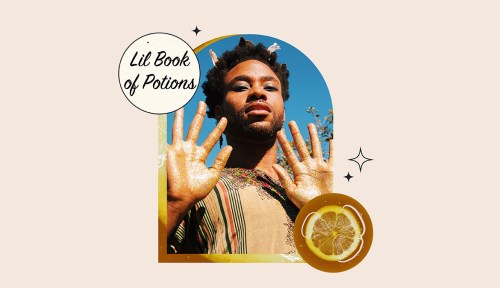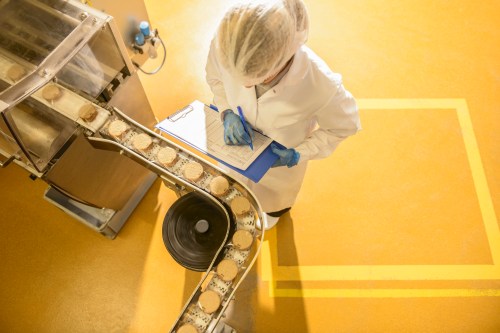A deep-rooted connection to the Earth was practically inscribed in Jordi’s DNA. The multi-hyphenate—they’re a performance artist, spiritual guide, activist, and healer—comes from a lineage of cooks who embraced the soul-nourishing aspects of nature’s bounty in every dish. “My grandmother, in particular, is very much an alchemist,” they say, describing how she “stands in front of fire and works with Earth’s elements to mold something that is tasty and delectable.” Watching her in the kitchen as a young child planted the first seeds for what would become Jordi’s newly released Lil Book of Potions, a collection of herbal mixtures corresponding to the 29-night moon cycle.
Experts in This Article
intuitive and spiritual coach
Fully growing into the herbalist behind the book, however, involved a lengthy journey of self-discovery. “A change happened in my mother around when I was 16, when she’d gotten out of a long, toxic relationship, where she began to focus intentionally on what we were putting into our bodies, and how certain foods could help us feel a particular way—help us feel good,” Jordi says. When they later left home for college and ran up against the swirl of systemic biases leveled at Black and queer people like themselves, they instinctively returned to what they knew: the grounding powers of natural things.
“When I became the one going grocery shopping, and I was the one using my energy and life force to make the foods I was eating and establish my surroundings, I realized the control I had over how I felt,” Jordi says. “I began to integrate essential oils and herbs and herbal teas into my own individual healing practice.” Not long after Jordi moved back to their hometown of Los Angeles after graduating college, their love for herbalism mixed with a drive for activism in such a way that made both passions more potent.
Jordi recently spoke with me* about how this unique synergy went on to shape their current approach to healing and inspire Lil Book of Potions.
Well+Good: At what point did you initially embrace the idea of becoming a healer?
Jordi: It took other people to name me as a healer, or to name that I had a proficiency and knowledge and an intuitive gift to share medicine with people and really shift their emotional, physical, and spiritual states.
“Remedies that I was using to address certain things within myself were being confirmed and affirmed by other people…so I felt compelled to keep showing up as a healer.”
I first started bringing essential oils to the traumatic spaces I found myself in as an activist, like Black Lives Matter demonstrations, as a means to comfort myself, and quickly found that people were so open to me sharing these medicines that I’d brought and putting oils on their bodies—and they were so communicative about how it affected them. These remedies that I was using to address certain things within myself were being confirmed and affirmed by other people. It compelled me to keep showing up as a healer in environments specifically built around organizing.
I facilitated mediations and poured libations for the spirits who had passed on or the people who had died, oftentimes literally, as I stood over blood shed on concrete beneath me. And that work graduated and evolved over the past two years into leading healing retreats, specifically for trans, nonbinary, and gender-nonconforming migrant folks who were released from ICE detention centers with Familia:TQLM, and also organizing healing for Black femmes with Jimanekia Eborn and her organization Tending the Garden.
How did you learn the herbalist techniques that you now use in your practice?
It started ancestrally. I got a DNA test and found out that my ancestors were mainly from southern Africa—Cameroon, Ghana, Nigeria—and quickly began to integrate what they ate into my diet. Then I learned from my great aunt that my great-great-grandmother would invite people to her home and have them tell her what they were going through, and she would make these herbal remedies. That’s really what I was doing, so a lot of it was tapping into my intuition.
I also was lucky to meet biochemist and cannabis researcher Brandie Cross, PhD amid Black Lives Matter organizing in Los Angeles. I had absolutely no lab experience, but they welcomed me into their lab and trusted my energy and my healing desires. I found myself literally studying shoulder-to-shoulder with this person for about two years, and learning the chemical aspects of these physical things whose spirits I’d already felt so connected to. And that really empowered me to say, ‘I know what my path is and what my purpose is.’ I realized I was doing this work not only for myself, but for my great-great-grandmother who didn’t have access to this kind of space, but knew about healing and had developed ways to help people instinctively.
When did your connection with the moon and the lunar cycle begin?
The moon stood out to me as I began to embrace spiritual practice, mostly because my relationship with time was skewing. I never really held a nine-to-five job; I was working in restaurants and in childcare, and also acting. My body craved consistency, and the lunar cycle was like a tether with time. It was like, ‘Hey, hold onto me. You know that in 29 days, it’ll always be a full moon, and if you use that to track events, you’ll be able to follow the thread of time and find patterns more easily, even when things are highly chaotic.
“My body craved consistency, and the lunar cycle was like a tether with time.”
There’s an ancient relationship that humans have with the moon, rooted in agriculture, based on when we tended to the land and when we harvested. And tuning into the lunar cycle became a way for me to get back to that sense of grounding, once I realized that the technologies and the go-go-go of capitalism were really depleting me of my own natural energy.
How do you use the lunar cycle in your work as a healer now?
My personal relationship with time might’ve been skewed a long time ago, but with the pandemic, it really was the collective relationship with time that got snapped. We were inside our homes so much that people quite literally started howling at the moon, singing out of their windows together. Throughout that time, the moon became a really clear reminder that there are always cycles in life, and wherever we are at any moment is not constant; even if you remain in the same physical place, change is still happening. And it was in that headspace that I started to channel the contents of this book.
Can you share the inspiration behind the 29 potions in your book?
When I first began formulating herbal blends, they were centered around five lunar events: the new moon, the full moon, the dark moon, the lunar eclipse, and the solar eclipse. And then the number 29 was really loud in my head because that’s the number of days in one lunar cycle, so that left me with 24 remaining spots—which I split into 12 for the waning moon period and 12 for the waxing moon period. The energy of the moon in each stage, then, inspired each herbal blend.
With the solar-eclipse potion, there’s a lot of yellow, vibrant, sun-based energy; I used lemon, ginger, turmeric, and honey. This is about returning our power to us—because with a solar eclipse, the sun is being blocked by the moon, which means the heat and light-source energy that we are typically given by the sun is blocked, as well. So, this blend is about finding and igniting that energy within ourselves instead. Lemon mixed with honey symbolizes turning sour into sweet, and ginger helps increase circulation and returns some of the warmth to our bodies that we lose when light is temporarily lost. As for turmeric, I included it for its anti-inflammatory effects. It aids in processing all the emotional energy that can be flung up during this time.
Jordi’s herbal potion for a solar eclipse
As we approach this eclipse season’s total solar eclipse—when the moon moves directly between the sun and the Earth—on December 4, Jordi shares how to make the herbal potion from the book created with this lunar event in mind:
Add one sliced lemon, a large thumb size of freshly grated turmeric and ginger, and as much honey as you’d like to a kettle (Jordi suggests a spoonful per cup of water). Boil with enough water to fill the kettle.
*This interview has been edited and condensed for clarity.
Oh hi! You look like someone who loves free workouts, discounts for cutting-edge wellness brands, and exclusive Well+Good content. Sign up for Well+, our online community of wellness insiders, and unlock your rewards instantly.
Sign Up for Our Daily Newsletter
Get all the latest in wellness, trends, food, fitness, beauty, and more delivered right to your inbox.
Got it, you've been added to our email list.










